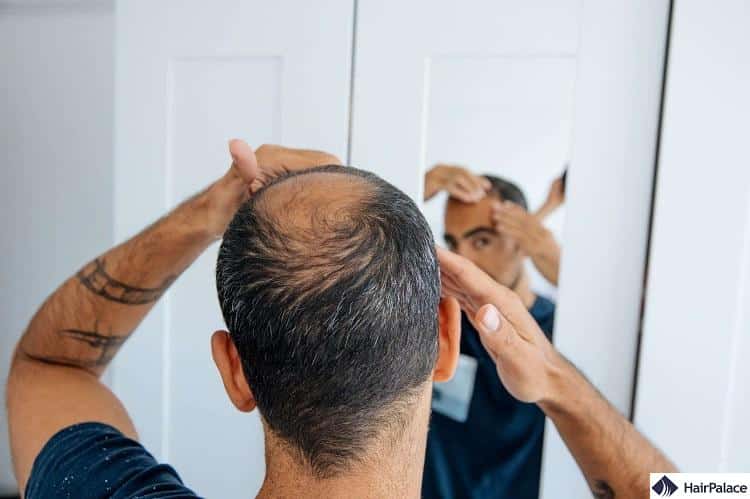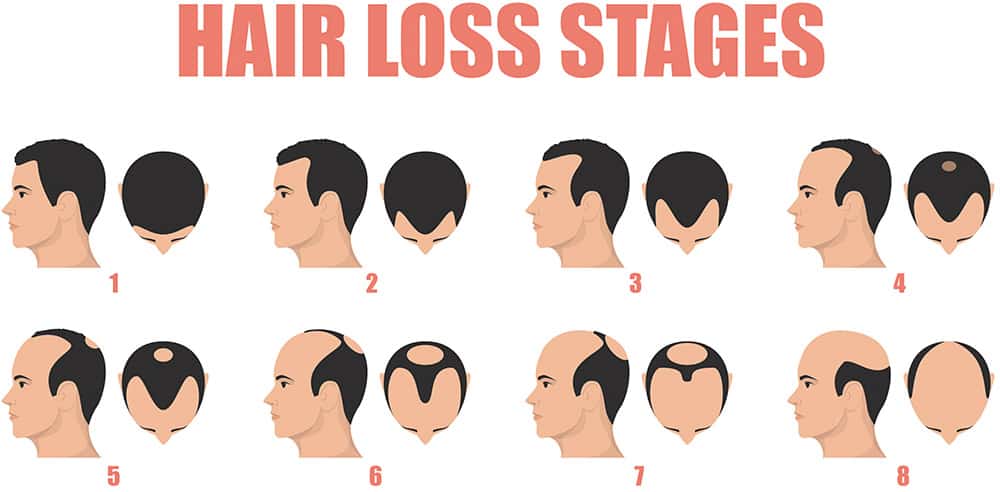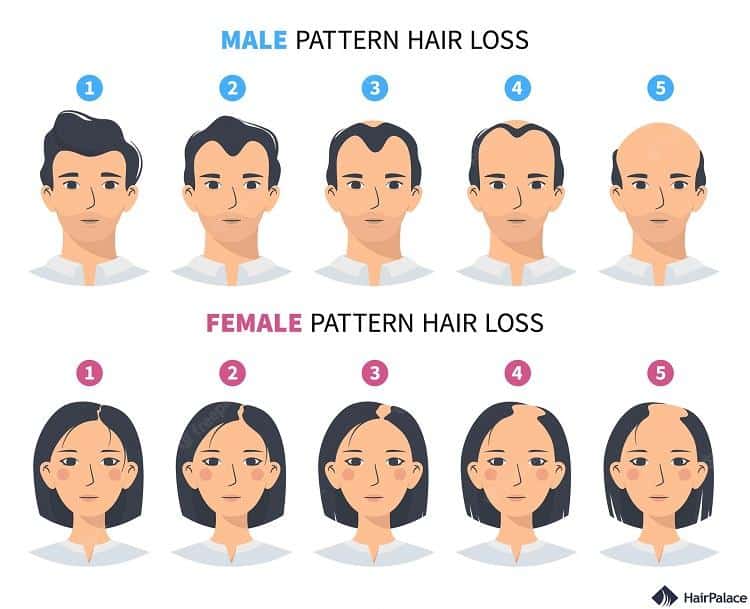Does Testosterone Cause Hair Loss? Learn the Truth in 2024

The relationship between testosterone and hair loss is complicated, to say the least.
While high testosterone levels don’t necessarily guarantee that your hair will fall out, it can be among the reasons for hair loss.
Particularly in individuals who are genetically predisposed to androgenetic alopecia.
This form of hair loss is influenced by the hormone dihydrotestosterone (DHT), a byproduct of testosterone.
DHT binds to hair follicles, causing them to shrink and produce thinner hair until growth ceases entirely.
However, having low testosterone levels can also cause issues.
But how exactly does testosterone cause hair loss in men and women?
Let’s find out!
- Types of testosterone
- How testosterone levels relate to hair loss
- Male pattern baldness
- Female pattern baldness
- Medical treatments
- Best home remedies
- When to see a doctor
Different types of testosterone found in the body
Testosterone is a male sex hormone. It is primarily produced by the testicles in males and the ovaries and adrenal glands in females.
Testosterone is responsible for the development of male sexual characteristics.
These include the growth of facial and body hair, the deepening of the voice, and muscle development.
There are two types of natural testosterone that can be found in the body:
1. Free Testosterone
This is the testosterone that is not bound to any protein in the blood.
It is the active form of testosterone that is able to enter cells and bind to androgen receptors.
2. DHT
DHT stands for dihydrotestosterone, which is a derivative of the hormone testosterone.
Dihydrotestosterone is formed when testosterone is converted into its active form by the enzyme 5-alpha reductase.
This enzyme is found in various tissues in the body, including the skin, prostate gland, and hair follicles.
This hormone is a potent androgen, meaning that it has strong androgenic effects on the body.
It is responsible for the development of male secondary sexual characteristics.
These include the growth of facial and body hair, the deepening of the voice, and the development of the male genitalia during fetal development.
However, excessive levels of DHT have been implicated in various medical conditions, including male pattern baldness, prostate enlargement, and acne.
Certain medications, such as finasteride, can act as DHT blockers and prevent the production of DHT.
Difference between having high testosterone vs low testosterone hair loss

Hair loss and hair thinning can be caused by a variety of factors.
Things such as genetics, ageing, hormonal imbalances, and certain medical conditions can all play a role.
Testosterone is one hormone that has been linked to hair loss.
However, the relationship between testosterone and hair loss is complex and still not fully understood.
High testosterone levels have been associated with hair loss in numerous studies.
More specifically, high levels of dihydrotestosterone (DHT), a potent androgen derived from testosterone, have been linked to male hair loss or male androgenetic alopecia.
This is the most common form of hair loss in men. DHT causes hair follicles to shrink, leading to thinner hair strands and subsequent hair loss.
On the other hand, low testosterone levels may also contribute to hair loss. Testosterone plays a role in the growth and maintenance of hair follicles.
Low levels of testosterone can lead to reduced hair growth and hair thinning.
Although this can be easily treated with the help of testosterone replacement therapy.
When it comes to hair loss caused by DHT, the situation is a little more complicated.
In order to effectively treat male pattern hair loss and female pattern baldness it is important to understand the nuances between these two conditions.
Male pattern baldness

Male pattern baldness or androgenic alopecia is characterized by a gradual thinning of hair on the scalp.
It typically starts at the hairline and crown of the head, and can eventually progress to complete baldness.
Male pattern baldness tends to run in families and is more common in men with a family history of the condition.
It typically begins in men in their 20s or 30s and becomes more common with age.
Female pattern hair loss

Female pattern hair loss is characterized by a diffuse thinning of hair on the scalp.
Unlike male pattern baldness, it usually causes dispersed thinning across the top of the scalp rather than a receding hairline.
Like male pattern baldness, female pattern hair loss is believed to be influenced by genetics and hormonal factors.
Women who experience sudden or severe hair loss should consult with a healthcare professional to rule out any underlying medical conditions.
3 Treatment options
There are several ways to treat testosterone hair loss, depending on the underlying cause. Here are some of the most common treatment options:
- Finasteride: By blocking dihydrotestosterone, finasteride can promote your hair follicles to enter into the anagen or growth phase of the natural hair growth cycle.
- Minoxidil: It is a topical solution that is applied directly to the scalp and is believed to work by increasing blood flow to the hair follicles and promoting hair growth.
- Hair transplant: A surgical procedure that involves removing hair follicles from a donor site on the scalp, typically the back or sides of the head. These hairs are then transplanted to the bald or thinning areas of the scalp.
2 best home remedies
1. Essential oils

There are several essential oils that are believed to stimulate hair growth and may be used for hair loss. Here are some of the most commonly recommended essential oils for hair loss:
- Rosemary oil: This oil is believed to improve hair growth by increasing circulation to the scalp and stimulating hair follicles. It may also help to reduce inflammation and oxidative stress, which can contribute to hair loss.
- Peppermint oil: Like rosemary oil, peppermint oil is thought to promote hair growth by increasing blood flow to the scalp. It may also have a cooling effect that can help to soothe an inflamed or itchy scalp.
- Lavender oil: This oil is believed to have antimicrobial properties that can help to maintain a healthy scalp and prevent dandruff or other scalp conditions that can contribute to hair loss.
- Cedarwood oil: This oil is thought to stimulate hair follicles and improve circulation to the scalp, which can promote hair growth.
- Tea tree oil: This oil is believed to have antifungal and antibacterial properties that can help to maintain a healthy scalp and prevent infections that can contribute to hair loss.
While essential oils may offer some benefits for hair loss, it is important to use them with caution and under the guidance of a healthcare professional or experienced aromatherapist.
Essential oils should be diluted with carrier oil before applying to the scalp, as they can be irritating or even toxic if used undiluted.
2. Vitamins

There are several vitamins that are believed to promote healthy hair growth and may be used to help prevent or treat hair loss. Here are some of the most commonly recommended vitamins for hair loss:
- Vitamin A: This vitamin is important for healthy hair growth and maintenance, as it helps to produce sebum, which moisturizes the scalp and hair. However, excessive intake of vitamin A can lead to hair loss, so it is important to take it in moderation.
- B vitamins: B vitamins, including biotin, niacin, and pantothenic acid, are important for healthy hair growth and may help to prevent hair loss. Biotin, in particular, is often recommended for people with thinning hair or brittle nails.
- Vitamin C: This vitamin is important for the production of collagen, which is a key component of healthy hair. It also has antioxidant properties that can help to reduce oxidative stress, which can contribute to hair loss.
- Vitamin D: This vitamin is important for overall health, and some research suggests that it may also play a role in hair growth. However, more research is needed to understand the relationship between vitamin D and hair loss fully.
- Vitamin E: This vitamin has antioxidant properties that can help to protect the scalp and hair follicles from oxidative stress. It may also help to improve circulation to the scalp, which can promote hair growth.
While taking vitamins may offer some benefits for hair loss, it is important to get enough of these nutrients through a balanced and healthy diet.
You should also talk to a healthcare professional before taking any vitamin supplements, as excessive intake of certain vitamins can be harmful.
When to see a doctor
It is normal to lose some hair every day, but if you notice excessive hair loss or thinning of your hair, it may be a sign of an underlying medical condition.
If you are concerned about your hair loss, it’s best to see a healthcare professional who specializes in hair loss, such as a dermatologist or hair restoration specialist.
They can help to determine the underlying cause of your hair loss and recommend appropriate treatment options.
Last medically reviewed on July 15th, 2024
- Ellis JA, Sinclair R, Harrap SB. Androgenetic alopecia: pathogenesis and potential for therapy. Expert reviews in molecular medicine. 2002 Nov;4(22):1-1.https://doi.org/10.1017/S1462399402005112
- Trüeb RM. Molecular mechanisms of androgenetic alopecia. Experimental gerontology. 2002 Aug 9;37(8-9):981-90.https://doi.org/10.1016/S0531-5565(02)00093-1
- Kaufman KD. Androgen metabolism as it affects hair growth in androgenetic alopecia. Dermatologic clinics. 1996 Oct 1;14(4):697-711.https://doi.org/10.1016/S0733-8635(05)70396-X
- Messender AG, Rundegren J. Minoxidil: mechanisms of action on hair growth. British Journl of Dermatology. 2004150(2):186-194.https://doi.org/10.1111/j.1365-2133.2004.05785.x
- Kaufman KD et al. Finasteride in the treatment of men with androgenetic alopecia. Journal of the American Academy of Dermatology. 1998;39(4):578-589.https://doi.org/10.1016/S0190-9622(98)70007-6
- Vera H. Price. Treatment of Hair Loss. N Engl J Med 1999; 341:964-973.https://www.nejm.org/doi/10.1056/NEJM199909233411307


